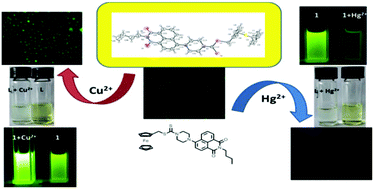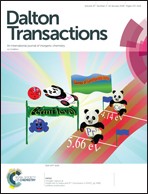A novel ferrocenyl–naphthalimide as a multichannel probe for the detection of Cu(ii) and Hg(ii) in aqueous media and living cells†
Abstract
A novel ferrocenyl–naphthalimide multichannel probe 1 was designed and synthesized using a facile method. The color of the solution containing probe 1 changed from yellow to colorless upon the addition of Cu2+ or Hg2+. Interestingly, probe 1 exhibited highly selective fluorescent turn-on for Cu2+ and turn-off for Hg2+ in aqueous solution. Probe 1 was an electrochemical Cu2+ and Hg2+ ion sensor, in which the Fc/Fc+ redox couple was significantly shifted (ΔE1/2 = 178 mV and ΔE1/2 = 53 mV, respectively) upon complexation. Therefore, probe 1 can act as a naked-eye chemosensor, as well as an electrochemical and a fluorescent probe for Cu2+ and Hg2+. Furthermore, this is the first reported probe that can be used for the bifunctional fluorescent detection of intracellular Cu2+ and Hg2+ by fluorescent imaging studies. These characteristics give this probe considerable potential in the study and analysis of Cu2+ and Hg2+ in complex biosystems.



 Please wait while we load your content...
Please wait while we load your content...